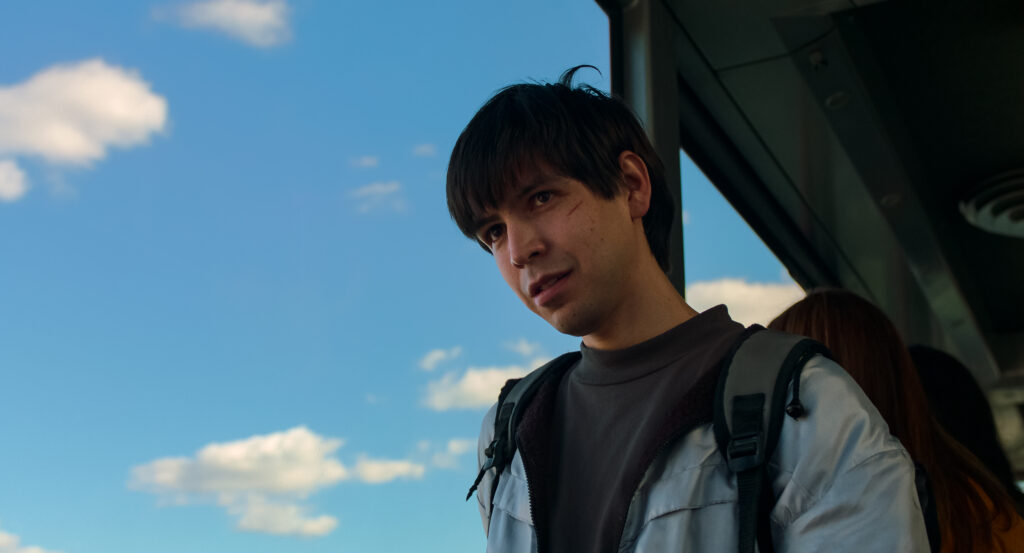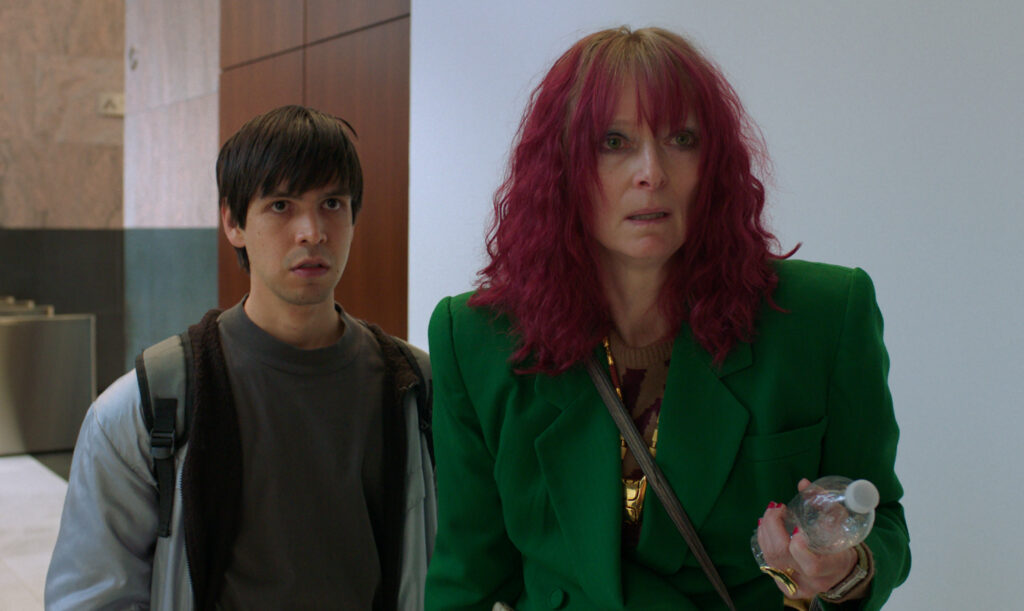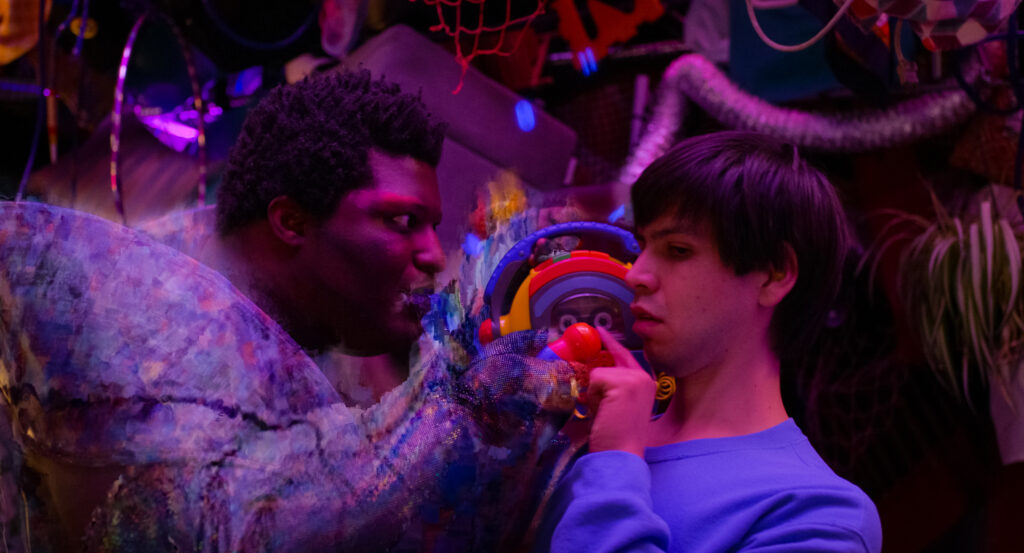By Chris Azzopardi
Photos Courtesy of A24
When I think of Julio Torres, I think of someone who gave life to Ferrero Rocher. It’s a wild detail to recall about someone, but indicative of Torres as a comedian who has the sharp wit and stone-faced delivery to make a comedy bit about a beloved chocolate and hazelnut confection more memorable than it has any right to be. During his HBO special “My Favorite Shapes,” which debuted in 2019, Torres, who is queer, hilariously acts like he’s doing us a favor by showing us what a square is, what a rectangle is and, of course, what the prized sphere is — “who you may recognize for her current role as a Ferrero Rocher chocolate,” he says. He brings out another Ferrero Rocher chocolate, this time without the additional wrapper it sits in.
“Originally, we had booked a different chocolate to play this part but then I was backstage and I was like ‘places, places’ and I was like, ‘I’m sorry, but where’s your little skirt?’”
Torres, a hyper-aware observational humorist, has built a career on his very special way of seeing the world and translating that into bone-dry comedy. He’s obviously a standout in “Los Espookys,” the Spanish-language horror-comedy from Fred Armisen that ran for two seasons on HBO, but even when he shows up as Patti Harrison’s co-worker at a coffee shop in “Together Together” for just a few scenes, you’re always wishing he could be the lead confection in a skirt.
He gets that starring role in “Problemista,” which the former “SNL” writer also wrote, and directed. Alongside Tilda Swinton, Torres plays Alejandro, an aspiring toy designer; the two create something otherworldly that is still very much grounded in our world — it is the tale of a person who needs a visa sponsorship to stay in the U.S. rather than return to El Salvador. The story, inspired by Torres’ own journey as a Salvadoran, he told NBC News, is, at its heart, one about outsiders — “people who feel that they are on the fringes.”
When I connected with Torres recently on Zoom, he talked about bringing his vision to life (minus the spaceships), a very specific element in Disney films that inspired the film visually and how he hopes his work can engender empathy for the experiences of those like Alejandro.

I’m interested in knowing how you get to the places you get to artistically, and with “Problemista,” how did you land where you landed? You started writing it during the pandemic, and I’m wondering if that experience took you to what we’re seeing on the screen now.
I think with me, it’s always a matter of reigning it in. I mean, the first version of the script would’ve amounted to a three and a half hour movie with three times the budget. We’re talking spaceships…
And real spaceships too, not CGI?
Real spaceships, not Hollywood spaceships, yeah. So with me, it’s about starting big and then eliminating the Xs and bringing in cohesion and remaining true to the vision. So that is usually the process, and I think that I consider myself to be an optimist and to be a very hopeful person. So, it wasn’t difficult for me to get to that place writing this movie when I did.
There is social commentary about immigration that’s really impactful and based on your own experience. Do you start with the social commentary or do you start with the spaceships?
I think I start with emotion. I definitely don’t start with social commentary. I think the social commentary comes as a byproduct of being honest and as a byproduct of showing truth, and truth comes from trying to accurately depict an emotion. So, I was not out to make some grand thesis statement about anything; I just really wanted to show how that process felt, and it is in the audience’s empathy that a commentary comes. The Bank of America scene, for example, is very cathartic because it shows you how those exchanges feel. And I set out to showcase that more than making any kind of statement.
How do you think a film like “Problemista,” and comedy itself, can help make issues like immigration more accessible to a broader swath of people and generate empathy?
I think that it’s [through] being very honest and being very specific and showing real people going through real problems and seeing characters not as vessels for ideas — seeing characters not as two-dimensional case studies that have no lives beyond the problems that they’re going through, but seeing them as fully fleshed beings that we can access real empathy. And that is the difference between consuming a work of fiction or getting to know someone and seeing a chart about any of these problems, right? It’s [about] people not as case numbers, but people as people.
How much overlap is there between you and Alejandro and his story?
There’s a lot of overlap. I think Alejandro is a part of me. He exists within me, so the process of acting here was more like putting a microscope on that and letting that part of me drive [the story].
When you’re dealing with something as fraught as immigration in your own experience, does your imagination allow you to access your optimism?
Maybe, yeah. Maybe because I enjoy creation so much and I enjoy being able to create things, and I create things for the joy of creating them, not for a greater agenda, not to please anyone. I don’t do something to get something else. I don’t do something to impress anyone. I do it because I feel that it’s fun and I feel compelled to, and I’m very, very, very lucky that I get to do that.

The opening scene features Alejandro with his mother who does what she can to protect her son. Was that scene inspired by your own life?
Yeah, yeah, yeah. A very, very loved, very protected person who was sort of in an incubator for the longest time. And yeah, no, it’s very true. And how that’s such a double-edged sword because you grew up with so much love, but you also grew up with no flaws. And this is the story of Alejandro knowing that he does have those flaws and that those don’t necessarily have to be for aggression, but they can be tools.
You recently said that, directing this, you brought together your visual and spatial interests, humor writing, story writing and world building. How did all those aspects of your work come together to create this film?
Everything is in conversation with each other, and everything is in service of everything else. And I am a very visual person, so I think visually. Even if it ends up being different, I do think about what people are wearing, what the environments look like, what the camera movements are like. And so, directing afforded me the opportunity to make those things happen and bring in other people to collaborate with, who have their own genius ideas and finding the best answers from all the options. And I don’t cook. I’ve never cooked. I’m a bad cook, but it sounds like cooking is a little bit like this.
About the visual references in “Problemista” — I was getting some “Alice in Wonderland” vibes from the beginning of the film.
Fairy tales are definitely influencing and informing this movie. I was a child in the ’90s, so I was watching a lot of the Disney animated stuff, and there was something that they would always do, which is they would have this huge orchestral music, and then you’d have this long pan into whatever the main architectural structure of the story was going to be. That was very important to just glide down until we got to the cave. And that’s the castle.

How did that detail about how you wanted to do that camera pan stick with you for so long?
Because they all follow the same recipe. I’m assuming that they thought it worked one time and then they did it over and over and over again. We glide on the jungle and then we end up in the rock where Simba is baptized or whatever that ritual is, and then we glide on Paris, and we find Notre Dame. We glide on Agrabah, and we find Aladdin’s castle; it’s all the same.
One of my favorite pieces of yours is “My Favorite Shapes.” Do you see a relationship between a project like that and a project like “Problemista”?
Yeah, they’re all coming from the same well. It just so happened that, at that point, I was in a time where what I wanted to say was best explained by showing little objects and, here, what I wanted to tell was best explained in this way. But all those worlds are connected.
Chris Azzopardi is the Editorial Director of Pride Source Media Group and Q Syndicate, the national LGBTQ+ wire service. He has interviewed a multitude of superstars, including Cher, Meryl Streep, Mariah Carey and Beyoncé. His work has also appeared in The New York Times, Vanity Fair, GQ and Billboard. Reach him via Twitter @chrisazzopardi.
